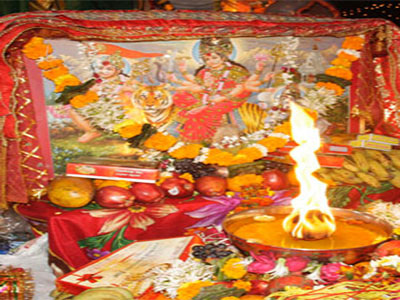
Navrati Puja
Benefits of Performing a Navratri Puja:
Navratri is the celebration of Maa Durga – the epitome of Shakti, in her various manifestations along with their varied powers.
Hence performing Navratri Puja is said to benefit in numerous ways like -
- Showers happiness, wealth and prosperity on the devotees.
- Fulfills wishes and desires.
- Bestows knowledge and spiritual enlightenment.
- Protects oneself and the household from evil and negative energies.
- Alleviates distress from life’s ongoing trials.
Occasions to Perform Navratri Puja:
Navratri falls around four different times in a year, which is celebrated with religious fervor across different parts of India. They include
1)Magh Navratri – It is mainly observed in certain parts of Northern India and falls between January and February.
2)Vasant Navratri – It falls between March and April and is also famously known as Ram Navratri or Chaitra Navratri.
3)Ashaadi Navratri – Observed by only certain regions in Northern India in the month of June or July.
4)Shardiya Navratri – Known as Maha Navratri. Celebrated across all parts of India, especially Western regions, either in late September or early October.
While the Magh and Ashaadi Navratri is known as Gupt Navratri celebrated by Saadhaks; the Chaitra Navratri and Shardiya or Maha Navratri is considered to be of utmost importance and celebrated with great zeal all across India.
Navratri Puja Vidhi:
Navratri celebrations include both – the Puja and Yagna rituals along with celebratory dance – Garba with devotional songs. Some people especially Gujaratis and people in western India, bring and setup Maa no Garbo, which represent welcoming Maa AdhyaShakti into their own house
The Puja vidhi begins with Ghatastapana which represents the invocation of Maa AdhyaShakti, done on the first day of the Navratri as per muhurat.
- A low table is covered with red cloth and placed at the most auspicious direction in the house, preferably near Puja Ghar.
- Maa Durga or Jagdamba’s photo or idol is place on the right on the table.
- A kalash filled with water is placed on the left. Five mango leaves and a coconut are placed over the kalash. The Kalash is placed over either wheat or rice grains on the table. Sacred Moli is tied around Kalash and a swastika is drawn in the front.
- A clay pot is filled with water and a few barley seeds are added to it as symbolic gesture of life-creation that Maa Adhyashakti represents.
- The clay pot is also kept near the table.
- A Tilak is applied to Maa Adhyashakti’s idol along with both the pots.
- Akshatas – Rice grains are offered.
- Garlands and Naivedya is offered to the Goddess.
- A Ghee diya is lit along with burning a dhoop and incense and an Aarti is performed.
- The Puja rituals are carried out each day for the following nine days.
- Many women perform Kanya Puja on the ninth day. This involves performing Puja of little girls who haven’t reached the age of puberty and feeding them the Special Bhog prepared on the day.
Mantras to Chant for Navratri Puja
First day is dedicated to Shailputri. Her Mantra is:
Vande vaanchhit laabhaaya chandrardha krita shekharaam |
Vrishaarudham shuladharam Shaila-putrim yashasvinim ||
We bow to Brahmacharini, invoking her with below mantra on the 2nd day
Dadhana Karpadma abhyamaksh Mala kamandalu |
Devi Prasidatu Mayi Brahmacharinya Nuttama ||
Chandrghata is worshipped on the 3rd day with the mantra below
Piṇḍaja pravarāruṛhā caṇḍakōpāstra kairyutā |
prasādaṁ tanutē mahyaṁ candra ghanṣṭēti viśrutā ||
We revere to Maa Khusmanda by chanting her Mantra on the 4th day
Dadhānā hastapadmābhyāṁ kūṣmāṇḍā śubhadāstu mē ||
Ya Devi Sarva Bhuteshu, Kushmanda Rupena Sansthita |
Namastasye Namastasye Namastasye Namoh Namah ||
On the 5th day we worship Skandamata by chanting the following mantra
Siṅghāsanagatā nityama padmāśritakaradvayā |
śubhadāstu sadā dēvī skanda mātā yaśaśvinī ||
Katyanani is revered on the 6th day. Her Mantra is
Om Hreeng Katyayini Namah ||
Kaalratri Maa is worshiped on 7th day with the following Mantra
Ya devi Sarvabhuteshu Maa Kalratri Rupenu Sansthitan |
Namastaseya Namastaseya Namastaseya Namo Namah ||
We invoke Mahagauri on the 8th day chanting the following Mantra
Shvete Vrishe Samaarudha Shvetaambar Dhara Shuchih |
Mahagauri Shubham Dadyantra Mahadev Pramodada ||
Meditate on Siddhidatri by chanting the following Mantra on the 9th day
Siddh Gandharv Yagyadhair Surair Marairapi |
Sevyamana Sada Bhooyaat Siddhida Siddhi ||
